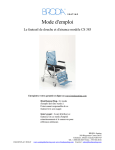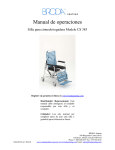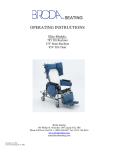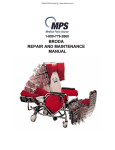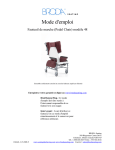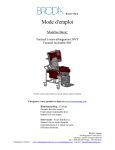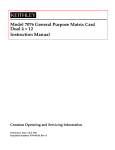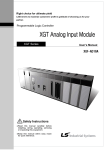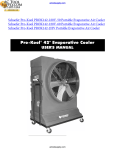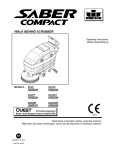Download SEATING OPERATING INSTRUCTIONS
Transcript
SEATING OPERATING INSTRUCTIONS Model CS 385 Commode Shower Chair Broda Seating 385 Phillip St. Waterloo, ON Canada N2L 5R8 Phone Toll Free: Can/US 1-(800) 668-0637 Fax: (519) 746-8616 www.brodaseating.com E-mail: [email protected] BRODA 385CS Commode Shower Chair Instruction for Use Foreword General Instructions 2 3 SAFETY INSTRUCTIONS 1.1 Before First Use 1.2 Application 1.3 Legal Restrictions 1.4 Position of Chair “Danger of Falling” 1.5 Position of Seat Tilt “Danger of Tipping” 1.6 Location of Chair “Danger of Tipping or Falling Objects” 1.7 Total Lock Wheel Brakes “Danger of Falling” 1.8 Re-Position of Resident “Danger of Clamping” 1.9 Unintended Movement “Danger of Falling or Collision” 1.10 Improper Restraint Use “Risk of Serious Injury” 1.11 Improper Use 1.12 Cleaning 1.13 Preventative Maintenance 1.14 Resident Specific Instructions 4 4 4 4 5 5 5 5 5 6 6 6 7 7 7 DEFINITIONS and TECHNICAL INFORMATION 7 2.1 2.2 2.3 2.4 7 8 9 10 Definitions Technical Information Shipping and Storage Specifications Labels CAREGIVER MANAGEMENT 11 OPERATION and MOVEMENT 4.1 Seat Tilt 4.2 Back Recline 4.3 Split Flip Down Footrest 4.4 Removable Side Panels 4.5 Removable Shower Seat 4.6 Removable Commode Seat 4.7 Commode Pan and Holder 4.8 Casters 4.9 Accessories 4.10 Seat Belt 4.11 Headrest 4.12 Lateral Supports 11 11 11 12 12 12 12 13 13 13 14 14 15 INSPECTION and FUNCTIONAL TESTING 5.1 Inspection 5.2 Functional Testing 15 15 16 6.0 7.0 8.0 RESIDENT SPECIFIC INSTRUCTIONS (Additions to Section 1) 385 SCHEMATIC DRAWING AND LEGEND TROUBLE SHOOTING FOR CYLINDERS 17 18 20 9.0 WARRANTY 22 1 BRODA 385CS Commode Shower Chair Foreword Congratulations on your purchase of a BRODA chair and thank you for your confidence in our company and our products. BRODA Seating has assumed a leadership position in providing the optimum in re-positioning functions and mobility for residents of long term care institutions. BRODA chairs do not look like traditional chairs and offer unique advantages found only with a BRODA. I am sure that after learning about BRODA, you will be convinced that your residents’ quality of life will be greatly enhanced in BRODA chairs. BRODA’s products were designed to be recommended by Professional Caregivers for residents’ who require long term care. The maximum benefit to the resident using this chair will be achieved with the advice and assistance of their Caregivers. This manual will assist you in making the best use of the functional capabilities of the BRODA chair and ensure that you will quickly become familiar with its use. If you have any questions about the safe and effective operation of your BRODA chair or accessories after reading this manual, immediately contact your local BRODA representative or our Head Office Customer Service personnel for further assistance. Head Office: BRODA Seating 395 Phillip St. Waterloo, Ontario, Canada N2L 5R8 Phone: Fax: E-Mail: Website: (519) 746-8080 Toll Free US/Can: 1 (800) 668-0637 (519) 746-8616 [email protected] www.brodaseating.com 2 BRODA 385CS Commode Shower Chair General Instructions The instructions contained herein provide guidance on the safe and correct operation of a BRODA chair. Safety measures as described in Section 1 must be observed when operating the chair’s functions or moving the chair. Only authorized caregivers should operate or move a chair. Every person that is involved with the operation and maintenance of the BRODA chair, including the resident’s family members, must read this instruction manual prior to moving or operating the functions of this chair. A copy of this instruction manual must always be available to these people. No person, including the resident’s family members, who is unfamiliar with or is unwilling or unable to adhere to the safety and operating instructions contained herein, should be permitted to operate or move the chair. A BRODA chair is designed for use within a Nursing Home, Hospital, or other Long Term Care facility where the potential users benefit from the assistance and care of professional caregivers. The safety and operating instructions that are included in this manual are very important to the safe and effective operation of the BRODA chair. The resident specific instructions attached to Section 7, as determined by the resident’s professional caregiver responsible for their seating, from a part of the safety requirements detailed in Section 1 and must be followed at all times. BRODA accepts no liability whatsoever for damage or disruptions caused by operating errors, failure to provide proper maintenance, or the disregard of the instructions contained in this manual, including the resident specific instructions. BRODA reserves the right to make changes to the specifications of the dimensions, functions, and components of its products. Any textual or diagrammatic representations provided are not necessarily exactly the same as the delivered products and are not required to obtain spare parts. Each BRODA chair is provided with a unique, identifying serial number. This serial number should be maintained on the chair and with your equipment records for future reference to obtain spare parts or additional copies of the operating instructions. 3 BRODA 385CS Commode Shower Chair 1.0 SAFETY REQUIREMENTS This section must be read by all operators of the BRODA chair before they attempt to use the product. It is the caregiver’s primary responsibility to ensure that only people who are familiar with the information contained in this manual are authorized to operate or move the chair. 1.1 Before First Use BRODA chairs are provided fully assembled and ready to use after purchaser inspection, functional testing, and training requirements have been met. If the chair does not appear to be in ready to use condition upon receipt, immediately contact your supplier and do not put the chair into service until after your concerns have been resolved. This manual must be read thoroughly by the caregiver(s) directly responsible for the resident’s nursing care before the chair is put into service. The chair must be visually inspected for damage, missing parts, and loose fittings (fasteners) prior to first use or testing the chair’s functions. Functional testing must be successfully completed after visual inspection and before first use. These obligations apply both to the first use of the chair and to all subsequent uses. (as described in Section 5, Inspection and Functional Testing) An inservice on the operation and safety issues, as described in this manual, must be given to the resident’s caregivers prior to its first use. (as described in Section 3, Caregiver Management) This manual must be read thoroughly by new caregivers, prior to the first time a new caregiver operates or moves the chair, after the chair has been put into service. A resident’s family members, who share some of the responsibility for a resident’s care, may be considered as a caregiver after they have read this manual, received instruction on the chair’s safe use by a professional caregiver, and a caregiver directly responsible for the resident’s care has given their approval. 1.2 Application BRODA chairs are intended exclusively for residents of long term care institutions who are under the care of professional caregivers. The CS 385 is intended for residents who need assistance with shower and commode needs. The CS 385 has interchangeable shower and commode seats that allow it to be used as a shower chair, a commode chair, or both. The suitability and application of a BRODA chair is to be determined by a professional caregiver who is familiar with the seating needs of the resident using the chair. Any other use of the chair is excluded from possible liability claims. The weight capacity of the CS 385 is a function of the casters. The casters can each bear weight of up to 220 lbs. The total weight is based on three casters, in the event that the chair is on uneven terrain, allowing the total weight capacity to be 660 lbs. The chairs are not explosion resistant and may only be used where there are no inflammable gases or liquids present such as anesthetics or petroleum based cleaners. BRODA chairs are designed for use with specific BRODA accessories and spare parts. Any use of non-BRODA spare parts or accessories with a BRODA chair is excluded from possible liability claims. Any use of BRODA spare parts or accessories on a non-BRODA product is excluded from possible liability claims. 1.3 Legal Restrictions BRODA chairs may only be used as described in this manual and with proper regard for recognized health care and work place safety and accident prevention practices. BRODA chairs may not be operated or used with non-BRODA spare parts or accessories, which could endanger residents, staff, or other third parties. The chair may only be moved or operated by caregivers or family members who can guarantee its correct operation because they have read and fully understood this manual and the safety issues discussed herein. 4 BRODA 385CS Commode Shower Chair 1.4 Position of Chair “Danger of Falling” Immediately after a resident is transferred into a chair, we recommend that the chair’s seat be tilted sufficiently to prevent the resident from sliding or falling forward off the chair. The amount of seat tilt used should be determined by the resident’s caregiver who is responsible for seating. We recommend that the resident’s feet be correctly positioned on the footrests slightly to fully elevated to prevent the resident from sliding or falling forward off the chair. The amount of elevation used should be determined by the resident’s caregiver who is responsible for seating. 1.4 Position of Seat Tilt “Danger of Tipping” We recommend that the chair’s seat be tilted sufficiently to prevent an agitated resident from tipping the chair forward or backward or from slumping and sliding in the chair. The amount of seat tilt used should be determined by the resident’s caregiver who is responsible for seating. 1.5 Location of Chair “Danger of Tipping or Falling Objects” We recommend that when a resident has been moved to their destination, the chair is located so the resident cannot reach handrails or other objects, fixed or moveable. This is to prevent the resident from pulling the chair over or pulling themselves off the seating surface and to prevent the resident from pulling moveable objects onto the chair and themselves. We recommend that the chair be used in a supervised area to prevent untrained residents, caregivers, or third parties from unauthorized operation, movement, or unsafe actions such as sitting or leaning on the reclined back, elevated footrest, or the armrests. These actions, if not prevented, put the chair at risk of tipping or damage to the chair. We recommend that a chair only be located on a level surface to minimize the risk of tipping over. 1.6 Total Lock Wheel Brakes “Danger of Falling” The special casters found on the BRODA chair have total lock brakes which prevent the wheels from turning and swiveling. The brakes must always be applied when: 1) 2) 3) the chair is not in use; a resident is being transferred (moved) into or out of the chair; and the chair is not being moved by a caregiver. It is important to note that if the wheel locks are applied while the patient is in the chair, that the caregiver does not leave the patient unattended, especially those patients who have the capability or tendency to move the chair and/or those who may be agitated. This could cause harm to the patient if they attempt to move the chair while the wheel locks are applied. Note that removing and attaching the footrest may be easier for the caregiver with the brakes applied Failure to follow these instructions will unnecessarily increase the risk of serious falls by residents, caregivers, or third parties caused by the chair unintentionally moving. 1.7 Re-Positioning of Resident “Danger of Clamping” BRODA chairs offer the benefits of seat tilt, back recline, legrest/footrest elevation, and moveable arms. During the movement of any of these functions, the following safety measures must be observed: 5 BRODA 385CS Commode Shower Chair 1) 2) 3) 4) 5) 6) 7) The resident’s arms must be positioned inside the chair frame with their hands on their body. The resident’s feet must be correctly positioned on the footrests. All of the chair’s brakes have been applied. Only one caregiver at a time attempts to operate the chair’s functions. Only one chair function is operated at a time. The rear wheels are in the trailing position, behind the chair frame The resident’s and caregiver’s body are clear of all pinch points Failure to follow these safety measures can put the resident's or caregiver’s limbs at risk of injury. Residents who may be unaware of their body position or unable to maintain a safe body position are at the most risk of the danger from clamping and caregivers should be more cautious with these residents. A second caregiver may be required to ensure the safety of these residents during these operations. 1.8 Unintended Movement “Danger of Falling or Collision” We recommend BRODA chairs for indoor use within a long term care institution and where there is not enough slope to cause the chairs to move unaided. Chairs used where the surface is uneven or sloped are at risk of unintended movement and could become a serious danger to the resident, caregiver(s), or a third party. We recommend that BRODA chairs are located away from stairwells, elevators, and exterior doorways within a long term care institution. 1.10 Improper Restraint Use “Risk of Serious Injury” We recommend that alternatives to physical restraints be used with residents while seated in the chair except under the specific instructions of the resident’s primary caregiver and with permission of the resident’s family or guardian. Physical restraints have been identified as a common cause of serious injury to residents while they are seated. We recommend that the primary caregiver responsible for seating first considers the re-positioning options available in the chair to reduce the risks of sliding, falling, or self injury. If a physical restraint is determined to be appropriate to prevent sliding or falling out of the chair, we recommend that the BRODA seat belt be used. In all cases, it is the resident’s primary caregiver who must take responsibility for the safety of the resident if restraints are used. 1.11 Improper Use The improper use of the chair can be dangerous to the resident, caregivers, or third parties through: 1) 2) 3) 4) 5) 6) 7) 8) 9) 10) 11) Unauthorized operation of the chair’s functions. Unauthorized movement of the chair. Inappropriate use of the chair for a resident who has not been assessed by the caregiver responsible for their seating. Attempted simultaneous operation of multiple chair functions by one or more caregivers. Attempting to move the chair with the brake(s) applied. Leaving the resident unattended in the chair near other objects. Leaving a potentially agitated resident in an unsupervised area. Leaving a resident in a chair on a sloping surface. Leaving a chair unattended on a sloping surface. Using non-BRODA accessories on the chair. Using the BRODA chair at temperatures below 0 Celsius (32 Fahrenheit) 6 BRODA 385CS Commode Shower Chair 1.12 Cleaning We recommend the chair be wiped clean with soap and water. A dilute household strength ammonia or chlorine based cleaner may be used if necessary. BRODA chairs should not be cleaned with petroleum based cleaners and any petroleum based products that come in contact with any vinyl surface should be removed as quickly as possible. Petroleum based products make vinyl brittle and will damage the seating surface and cushions. Metal parts and cushions should be wiped dry after cleaning. Solvents such as those found in spray lubricants should not be used on Broda chairs as they can damage moving parts. Touch up paint is available for the power coated frame. Please call Broda’s Customer Service Department if touch up paint is required. 1.13 Preventative Maintenance The maintenance on a BRODA chair will vary with the amount of use and the condition of the resident using the chair. We recommend regular visual inspection for signs of wear, damage, loose or missing fittings, and other safety concerns. Also, periodic testing of the chairs functions is appropriate. If a breakage, defect, or operational problem is detected, the chair must be repaired, inspected and tested for function before it is returned to service. In regular use, the chair should be inspected and tested on a bimonthly basis. The chair should be inspected and tested as often as each use if the chair is used: 1) By aggressive or agitated residents. 2) By residents who have involuntary movement. 3) On irregular or sloped surfaces. 4) By residents weighing over 220 lbs 5) By any unauthorized person. Do not use any lubricants that contain solvents. Solvents will damage many of the moving components in the chair. If necessary a white, food grade grease (lubricant) may be used on the sliding components in the chair. Do not use spray lubricants as they contain solvents. 1.14 Resident Specific Instructions The professional caregiver responsible for the resident’s seating shall add such additional instructions as are necessary for the safety and comfort of the resident using the chair based on their professional experience and knowledge of the resident’s specific conditions and requirements. These instructions form a part of the Safety Requirements for using the chair with that resident and must be made available to all caregivers. (see Section 7) 2.0 DEFINITIONS and TECHNICAL INFORMATION 2.1 Definitions “BRODA” means Broda Enterprises Inc. doing business as Broda Seating. BRODA “chair” refers to model 385 CS Commode Shower Chair. “Long Term Care Institution” refers to a Nursing Home, Hospital, or other Health Care facility that provides health and personal care to its residents on a long term basis. “Resident” refers to an individual living in a Long Term Care Institution under the care of Professional Caregivers. “Professional Caregiver” refers to the Doctors, Nurses, Therapists, Nurses Aids, Health Care Aids, and other Specialist who work in a Long Term Care Institution and provide health and personal care to its residents. “Caregiver” refers to any person in a Long Term Care Institution who is appropriately trained to provide care or services to the resident or the chair used by the resident and may include the resident’s family members or guardian. 7 BRODA 385CS Commode Shower Chair “Seat Tilt” refers to changing the angle of the chair’s seat with respect to the chair frame (or ground) without changing the angle between the back and the seat. “Back Recline” refers to changing the angle between the chair’s back and the chair’s seat. “Footrest Elevation” (and Legrest elevation) refers to changing the angle between the chair’s footrest (and legrest) and the chair’s seat. “Transfer(s)” refers to the movement of a resident into or out of a chair with the assistance of their caregiver(s). “Mechanical Transfer(s)” refers to the movement of a resident into or out of a chair with the assistance of their caregiver(s) using a patient lift or other assistive device that bears the weight of the resident. “Safety Requirements” are the important information contained in Section 1 which must be followed to ensure the safe operation of the chair for the resident, caregivers, and third parties. 2.2 Technical Information Dimensions When the chair is upright, overall dimensions are 49 inches high by 28.5 inches wide by 32 inches long. When the chair is fully reclined, overall dimensions are 30 inches high by 28.5 inches wide by 44 inches long. Seat width is 22 inches measured between the arms. Seat Depth is 18 inches. Seat height is 23.5 measured to the front vinyl strap in the seat. The legrest is 12 inches long and 21.5 inches wide. The footrest is 11 inches deep by 20 inches wide. The footrest can be adjusted to 16, 18, 20 and 22 inches in length. Net chair weight is approximately 65 lbs. Chair Frame The frame is all stainless steel construction. The base, back, side panels, arms, legrest, and footrest are powder – coated for durability and corrosion resistance. m Adjustments to the seat tilt, back recline, and independent legrest elevation functions are supported by a mechanical locking device designed to permit controlled movement during the operation of these functions. (see Section 4, Operation and Movement). No motors or other powered devices are used in the chair. Casters The CS 385 has 5 inch total lock front casters with non-marking grey rubber tires and 220 lb. weight capacity. The rear casters are one 5 inch total lock and one 5 inch directional (dark grey pedal) lock caster with nonmarking grey rubber tires and 220 lb. weight capacity. The casters require minimal maintenance. Lubrication or maintenance may be required in extreme conditions such as steam cleaning, pressure washing or autoclaving. Side Panels The side panels help with containment, and are swing away and removable to assist in side transfers. 8 BRODA 385CS Commode Shower Chair 2.3 Shipping and Storage Specifications BRODA chairs should be shipped and stored in an upright condition and not stacked higher than 3 boxes. No other materials should be shipped or stored on top of a BRODA box. BRODA boxes should not be placed on pallets BRODA chairs should be shipped and stored at temperatures between minus 20 degrees Celsius and plus 40 degrees Celsius. BRODA chairs should not be used until they are between 0 degrees Celsius and 30 degrees Celsius. BRODA chairs should be kept in a clean, dry environment. Upon receipt, we recommend that the shipping carton be immediately examined for damage. Any damage should be noted on the delivery receipt and a request for inspection by the transportation company should be made. The shipping carton should be opened immediately and the chair examined for concealed shipping damage. If the chair appears to be damaged, a concealed bad order report should be immediately filed with the transportation company. 9 BRODA 385CS Commode Shower Chair 2.4 Labels BRODA uses certain labels to assist caregivers to identify items which permit the operation of the chair’s functions. Recline Label (Blue) Swing Away Arm Label (Grey) TO REMOVE ARM BACK RECLINE SQEEZE HANDLE PUSH DOWN ON ARM WHILE Seat Tilt Label (Tan) PUSHING BUTTON SEAT TILT Serial Number Label (Grey) SQUEEZE HANDLE SEATING 1-800-668-0637 Manufacturer’s Label (White) PRODUCT # SERIAL # MADE IN CANADA MADE IN CANADA / FABRIQUE AU CANADA 385 Phillip St., Waterloo, ON. Canada, N2L 5R8 PHONE 1 – 519 746-8080 FAX 1-519-746-8616 10 BRODA 385CS Commode Shower Chair 3.0 CAREGIVER MANAGEMENT BRODA Seating’s unique and innovative chairs provide the optimum in re-positioning functions and mobility. However, BRODA’s products were designed to be recommended by professional caregivers. The maximum benefit to the resident using this chair will be achieved with the advice and assistance of their caregivers. The professional caregiver responsible for the resident’s seating will add any additional resident specific instructions required for the safe and correct operation of the chair with a specific resident to Section 7 at the end of this manual. These additional resident specific instructions shall be considered as important additions to the Safety Requirements in Section 1. At the customer’s request, the initial basic training of the resident’s caregiver(s) in the operation of the chair will be provided by the local BRODA representative who supplies the chair. The caregiver(s) must adhere to the Safety Requirements at all times to ensure the safety of the resident, caregivers, and third parties. The customer will maintain a list of caregivers who have read this manual and are authorized by them to operate and move the chair. BRODA assumes no liability for damage, injury or accidents caused by careless, negligent, incorrect, or unauthorized operation or movement of its chairs. 4.0 OPERATION and MOVEMENT Safety measures as described in Section 1 must be observed when operating the chair’s functions or moving the chair. Only authorized caregivers should operate or move a chair. 4.1 Recline Handle Seat Tilt The seat can be tilted to any position from the most upright to the lowest within its range. This assists the caregiver in changing a resident’s body position to: minimize falling or sliding forward, increase the stability of the chair to minimize the risk of tipping over: and, improve the resident’s comfort. - Place right hand on tilt bar and squeeze tilt handle with left hand Push Bar Tilt Handle -Raise or lower seat tilt until desired angle is achieved- Push down on push bar for posterior tilt and pull up for anterior tilt. Caution: When using anterior tilt, observe patient in chair to ensure he/she won’t fall foward -Release handle once seat is in desired position 4.2 Back Recline Posterior Tilt Anterior Tilt The back can be reclined to any position from the most upright to the lowest within its range. This assists the caregiver in changing a resident’s body position to: improve the resident’s comfort; or to assist caregivers in providing daily care activities. Note: Always tilt slightly before reclining to prevent patient from sliding - Place right hand on tilt bar and squeeze tilt handle with left hand - Raise or lower back until desired angle is required. -Release handle once back is in desired position Note: Do not operate tilt and recline handles together 11 Reclined Position BRODA 385CS Commode Shower Chair 4.3 Flip Up/Down Footrest The footrest may be flipped up to provide easier access to the front of the chair by residents’ during transfers. The footrest should be attached to the legrest at the location which provides correct foot support for the resident as determined by the caregiver. If a mechanical transfer is used by the caregiver, the footrest should be left in a flipped down position. - Insert right end of upper cross piece of footrest into desired hole on legrest. Push footrest to the right to activate spring mechanism on cross piece of footrest - Line up left end of cross piece of footrest with corresponding hole on legrest Cross piece of footrest inserted into hole on legrest - Release tension on spring mechanism. The left end of cross piece will enter hole 4.4 Removable Arms The arms are swing-away and removable to permit access to the chair from the side. -Push down on front of armrest with one hand, and press push button with other hand - Let armrest “pop up” - Swing away side panel or remove completely Push Button To attach: - Insert back end of arm into back receptacle first and insert front end into front receptacle. Push down on arm until button pops into button hole with a clicking sound 4.5 Removable Shower Seat The CS chair is available with shower seat, commode seat or both. These options are interchangeable. To remove: Undo the safety strap that attaches the front of the seat to the frame of the chair -Standing in front of the chair, place hand on front corner of seat. Lift up and release all four clips that attach seat to chair frame. To Attach: Set seat on chair and push down so that all four clips attach to the chair frame and secure the safety strap to the frame of the seat 4.6 Removable Commode Seat The commode seat is interchangeable with the shower seat and is used with a commode pan and holder To remove: Standing in front of chair, place hands on sides of commode seat near front and lift and slide toward front of chair. To attach: Set seat on chair towards back over the frame and push down to secure 12 Removing Seat Attaching Seat BRODA 385CS Commode Shower Chair 4.7 Commode Pan and Holder The plastic commode pan and wire pan holder are used together with the commode seat when using the chair for toileting. To place pan holder on frame: - Standing in front of chair, insert holder into holes at front of chair on inner side of chair frame, one prong at a time (end with short prongs, see right) When inserting front portion of holder, ensure that back of holder is underneath frame of chair at the back Insert into holes on back of chair frame Insert into holes on front of chair frame - Insert holder into holes at back of chair on inner side of frame, one prong at a time. To remove pan holder: - Standing in front of chair, remove holder from back of chair frame, by pushing down or pulling forward slightly on wire and removing prongs Commode pan holder inserted into chair frame - Remove prongs from front of chair Commode Pan - To insert: Standing behind chair, place outside edges of pan along wire holder and slide pan towards front of chair -To remove: stand at back of chair and slide pan towards back of chair, keeping it level 4.8 Casters The CS 385 has all stainless steel casters. It has 3 total lock casters that swivel, and one directional locking caster for tracking. The tracking feature allows for easy maneuverability. Each caster has a locking feature - To lock casters into place, press down light grey pedal with foot. Press pedal back up, to release Rear of Chair - To set in tracking position, use rear directional locking caster. (dark grey pedal) Press pedal down with foot. Press pedal back up, to release from tracking position 4.9 Total Lock Caster Directional Locking (Tracking) Caster Accessories We recommend BRODA accessories for use only on BRODA chairs. The correct installation of the BRODA accessory is very important. We recommend that the BRODA chair is ordered with the required accessories already installed. Only authorized caregivers who thoroughly understand the accessory installation procedures should attempt to install their BRODA accessories without assistance from their local BRODA representative. 13 BRODA 385CS Commode Shower Chair 4.10 BRODA Unpadded Seat Belt The BRODA unpadded seat belt may only be used if recommended by the resident’s primary caregiver and permission is given by the resident’s family or guardian. The BRODA seat belt is specially designed to work with your BRODA chair. Properly attached this accessory securely holds a resident in a chair with a minimum of risk from the belt. - The Seat Belt must be attached by sliding the end of the belt between first and second strap of the chair back and wrapping it around the metal tube. - Slide the belt through both ‘D’ rings, come back through one ‘D’ ring and attach to the velcro (figure A). - Repeat this process on the other side (note there is only one ‘D’ ring and no velcro). Any excess belt material should be tightened sufficiently to prevent unwanted movement of the belt but with caution to ensure resident comfort is not compromised. If the caregiver is unsure about the correct installation or operation of the BRODA seat belt, the caregiver should contact their local BRODA representative for assistance before attempting to use this accessory. Figure A 4.11 Broda Head Rest The BRODA headrest is specially designed to work with your BRODA chair. When the chair is reclined, this accessory assists the caregiver when washing a resident’s hair and provides a comfortable position for the residents head. The headrest is available unpadded or padded. The padded headrest is made of polyethylene closed-cell foam, to prevent water absorption. -Using the hardware provided, attach the gray powder coated bracket to the back of the chair through the two holes in the top of the chair. -Slide the stainless steel headrest through the bracket and secure using the hand-wheel provided. Using the handwheel allows infinite positioning of the headrest. Unpadded Head Rest Padded Head Rest 14 BRODA 385CS Commode Shower Chair 4.12 Lateral Supports The CS 385 Lateral Supports are made of Polyethylene closed cell foam. They can be adjusted horizontally along the back of the chair to accommodate individual residents. - Remove the thumb screw and washer to release the plastic backing to the bolster - Choose a position vertically along the back of the chair to which the bolster should be attached - Sandwich the bolster and the plastic backing to the chair straps, so that the holes in the bolster are in line with the holes in the backing - Fasten the plastic backing to the bolster with the thumb screws and washers - Before the bolster is tightly secured to the chair, it can be positioned along the straps to achieve optimum positioning for the resident 5.0 INSPECTION and FUNCTIONAL TESTING Safety measures as described in Section 1 must be observed when inspecting or testing a chair. Only authorized caregivers should attempt to inspect or test a chair. 5.1 Inspection We recommend regular visual inspection for signs of wear, damage, loose or missing fittings, and other safety concerns. If a breakage, defect, or operational problem is detected, the chair must be repaired inspected and tested for function before it is returned to service. We recommend that the chair be inspected as often as each use if there is any reason to be concerned about the possibility of increased wear or loose or missing fittings. At a minimum, in regular use the chair should be inspected on a bimonthly basis. The visual inspection procedure should include at least the observation of the following fittings (fasteners): 1) 2) 3) 4) 5) 6) The two bolts and two nuts which attach the rear casters to the chair base. The two bolts and two nuts which attach the front casters to the chair base. The nuts and bolts that attach the 4 cylinders that position the seat tilt, back recline, and independent legrest elevation. The two bolts and two nuts which attach the chair back to the chair seat. The nuts and bolts on the footrest plates The nuts and bolts which attach the legrest to the front of the chair The visual inspection procedure should include at least the observation of the following parts: 1) 2) 3) The 5 cylinders that position the seat tilt, back recline, and independent legrest elevation. The vinyl straps used in the seat, back, legrest, and footrest. The 3 black handles and cables. We recommend the visual inspection procedure should include the observation of any installed accessories as described in Section 4.8. 15 BRODA 385CS Commode Shower Chair 5.2 Functional Testing We recommend that the chair should be tested for operation of the chair’s functions without a resident in the chair. The testing may be as often as each use if there is any reason to be concerned about the possibility of increased wear or damage to the chair’s components. At a minimum, in regular use the chair should be tested for functions as described in Sections 4.1 to 4.12. If the caregiver performing the functional testing believes that any function is not operating correctly, the chair should be taken out of service until a satisfactory functional test can be completed. The caregiver performing the testing should be aware that the seat tilt, back recline, and footrest (legrest) elevation operations will be more difficult without a resident in the chair. When performing repairs or maintenance, do not use any lubricants that contain solvents. Solvents will damage many of the moving components in the chair. If necessary, a white, food grade grease (lubricant) may be used on the sliding components in the chair. Do not use spray lubricants on any part of the chair. 16 BRODA 385CS Commode Shower Chair 6.0 RESIDENT SPECIFIC INSTRUCTIONS The suitability and application of a BRODA chair is to be determined by a professional caregiver who is familiar with the seating needs of the resident using the chair. BRODA and our representatives are not professional caregivers and will not know the specific requirements of the individual resident using the chair. BRODA relies on the knowledge, experience, and judgment of the resident’s professional caregiver to ensure the safety and comfort of the resident while using the chair. The primary caregiver responsible for the resident’s care and the caregiver responsible for the resident’s seating, shall add any specific instructions necessary for the safe and effective use of the chair. These instructions form an important part of the Safety Requirements for using the chair and must be made available to all caregivers. Space is provided here to include or attach these important instructions. ______ 17 BRODA 385CS Commode Shower Chair 7.0 Broda Seating CS 385 Parts Schematic Drawing Please have the chair serial number ready when contacting Broda or your local representative for parts or assistance for your chair. The serial number can be found on a grey label on the rear of the chair. 18 BRODA 385CS Commode Shower Chair Broda Seating CS 385 Parts Schematic Legend # 1. 2. 3. 4. 5. 6. 7. 8. 9. 10. 11. 12. 13. 14. 15. 16. 17. 18. 19. Description Base for commode/shower chair 5” plastic directional lock caster 5” plastic caster total lock Seat mount for commode/shower chair Legrest for commode/shower chair Gas spring assembly non locking with head Gas spring assembly locking with release head Back for commode/shower chair Gas spring assembly locking with release head Cable assembly consisting of cable, handle, mounting screw Removable arm for commode/shower chair Retaining spring for removable arms Black armrest c/w mounting screws Upper half commode/shower chair footrest Lower half commode/ shower chair footrest Rod for commode/shower chair footrest Compression spring for footrest rod Shower seat for commode/shower chair Mounting clip for shower seat 19 Part Number FPP-CS-BASE00 CASTER5”PD” CASTER5”PT” FPP-CS-ST-MNT00 FPP-CS-LGRT1400 PAB4-NL PAB4 FPP-CS-BACK PAB5 PRT-CABLEASSEMBLY FPP-CS-ARM00 ASFASPRO0000000 PRT-A-3 FPP-CS-SFUPPER0 FPP-CS-SFLOWER0 FPP-CS-FTRTROD ASFASPRE0000003 FPP-CS-ST-SHWRO PRT-SEATCLIP BRODA 385CS Commode Shower Chair 8.0 TROUBLE SHOOTING FOR CYLINDERS Gas Cylinders The use of gas charged springs on Broda products allow the caregiver to easily make adjustments to the tilt, recline, and leg rest with a minimum amount of effort. The gas cylinders contain Nitrogen gas, it is not flammable nor is it toxic. The cylinders provide a lifting force of 300 Newtons (approx. 68 Lbs). In other words the cylinders reduce the amount of weight the care giver has to lift by 68Lbs. How do they work? On the end of the stem of the cylinder is a small pin. When the operator depresses the Handle this pulls on the cable which in turn pulls on a small lever inside the actuator mechanism into which the stem of the cylinder is mounted. This depresses the pin and this in turn opens a valve located inside the barrel of the cylinder. This allows for changes in position. When the operator releases the handle the valve closes and locks the cylinder in the desired position. Over the years Broda has used many different types of actuators to operate the gas cylinders used on our products. Although they may look different their function is one and the same (to push against the pin and open the valve that controls the cylinder). If the cylinder is not properly adjusted when mounted in the actuator, problems are sure to arise. Maintenance The gas cylinders do not require any maintenance, although they may need to be adjusted due to wide temperature variations or cable stretch. When adjusting the cylinder it is important that you do not damage the stem on the cylinder. Small scratches left by applying the jaws of pliers or Vice Grips directly to the shaft while making adjustments will destroy the seal and allow the gas inside the cylinder to escape. Use a piece of vinyl strapping or rubber to protect the cylinder shaft from the jaws of the tool you are using to make the adjustments. Trouble shooting: Often when experiencing problems with cylinders on Broda chairs, the cylinder is not bad, it just needs adjustment. There are two common adjustments. 1. 2. The pin that the cable handle pulls on at the end of the cylinder is not connected correctly. Or the handle or cable assembly have become broken or disconnected. The cable mechanism works exactly like a bicycle brake and is easy to check when experiencing problems. Other solutions to common problems are listed below. 1. 2. Chair is not reclining or tilting when cylinder handle is pulled. a. The pin in the end of the cylinder is not being depressed when the handle is pulled. Action to take: See adjustment steps The chair seems to slowly slide out of position a. The pin in the end of the cylinder may be still partially depressed. Action to take: See adjustment steps. 20 BRODA 385CS Commode Shower Chair Adjustment Steps Note: Cylinder does not need to be removed from the chair to make this adjustment. 1. 2. Loosen the lock nut located on the stem of the gas cylinder next to the actuator (17mm or 11/16” wrench). From the above instruction determine whether you want to wind the stem further into the actuator or further out of the actuator. You will need to wind the stem further into the actuator if the chair is not tilting or reclining, (wind it clockwise) and wind it further out of the actuator if the chair is slowly sliding out of position. (wind it counter-clockwise) Note: When adjusting cylinders with tools that come in contact with the cylinder rods. A cloth, piece of vinyl strap, or some other protective material must be used to protect the sliding surface of the rod. If the rod becomes scratched or scarred it will puncture the seal on the cylinder and the cylinder will fail. Damaging a cylinder in this fashion voids the manufacturer’s warranty. 3. Wind the stem in the correct direction one half turn. When viewing the cylinder with stem pointing towards you turn the stem clockwise to wind the stem out of the actuator and counter-clockwise to wind the stem into the actuator. 4. 5. Check the function of the cylinder and repeat steps 3 & 4 until the cylinder functions properly. Tighten the lock nut loosened in step 1. If adjusting the cylinder does not correct the problem, the cylinder may need to replaced. Please contact Broda at 1-800-668-0637 or your local area representative. 21 BRODA 385CS Commode Shower Chair BRODA SEATING WARRANTY BRODA provides a Three Year Warranty on the chair frame, and a One Year Warranty on all other components subject to the following conditions: No warranty is provided on seat pads or cloth covers. The chair frames are guaranteed for three years against structural defects or failure. All other parts (except seat pads and cloth covers) including but not limited to strapping, cushions, gas springs and attachments, casters, wheels, brakes and armrests are guaranteed for one year against defects in materials and workmanship based on normal institutional use. The guarantee does not cover malicious or deliberate damage or damage from misuse. The guarantee does not cover use of Broda chairs in a shower or pool, with the exception of the Broda Commode/Shower Chair. Modifications to Broda products or the use of non-Broda supplied parts voids the warranty. This warranty does not cover shipping damage (see below). BRODA will provide new or refurbished parts for installation by the owner at no cost following confirmation by the local BRODA Representative or the BRODA Head Office Customer Service Representative. On request, defective parts must be returned to the factory within thirty days of receipt of the replacement parts by the owner. If the defective parts are not returned to BRODA on request, the owner will bear the cost of the replacement parts on invoice from BRODA. Warranty does not include on-site labor for the installation of warranty parts or warranty repairs. The owner may return to BRODA products for warranty replacement or repair by shipping items prepaid and insured to the factory. Warranty completed at the factory includes both materials and labor. Parts to be repaired or replaced at the discretion of BRODA. All returns to the factory require prior authorization from BRODA. BRODA retains the right to make design and application changes without notice. All orders will be filled with BRODA's current models unless otherwise specified by the purchaser. BRODA chairs are designed for patient mobility, positioning, and comfort in specialty seating, however, the application of BRODA products shall remain the responsibility of the purchaser or user. This warranty is not transferable. RETURNS BRODA Seating will not accept any returns without a prior Returned Goods Authorization Number. Please contact our Head Office Customer Service Representative at 1-800-668-0637 for assistance. Returns must be insured when shipped. DAMAGED FREIGHT NOTIFY THE CARRIER OF ANY DAMAGE IMMEDIATELY It is the responsibility of the person receiving the goods to examine cartons and goods before accepting receipt. Note all damages on the bill of lading and file a claim if necessary. Notify the carrier of any concealed damaged within a maximum of 48 hours. BRODA insures all products for intransit damage, failure to notify the carrier of intransit damage voids both the insurance and the BRODA warranty. If you require assistance, please contact our Head Office at 1-800-668-0637. SALES TAX Most Broda products are G.S.T. Zero Rated and Exempt from Canadian Provincial Sales Tax. Purchasers maybe required to check with their Provincial or State Tax Office for purchaser tax payment. 22























